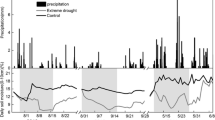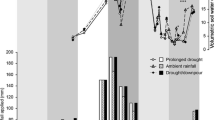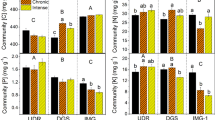Abstract
Climate change will increase the recurrence of extreme weather events such as drought and heavy rainfall. Evidence suggests that extreme weather events pose threats to ecosystem functioning, particularly to nutrient cycling and biomass production. These ecosystem functions depend strongly on below-ground biotic processes, including the activity and interactions among plants, soil fauna, and micro-organisms. Here, experimental grassland and heath communities of three phytodiversity levels were exposed either to a simulated single drought or to a heavy rainfall event. Both weather manipulations were repeated for two consecutive years. The magnitude of manipulations imitated the local 100-year extreme weather event. Heavy rainfall events increased below-ground plant biomass and stimulated soil enzyme activities as well as decomposition rates for both plant communities. In contrast, extreme drought did not reduce below-ground plant biomass and root length, soil enzyme activities, and cellulose decomposition rate. The low responsiveness of the measured ecosystem properties in face of the applied weather manipulations rendered the detection of significant interactions between weather events and phytodiversity impossible. Our data indicate on the one hand the close interaction between below ground plant parameters and microbial turnover processes in soil; on the other hand it shows that the plant–soil system can buffer against extreme drought events, at last for the period of investigation.





Similar content being viewed by others
References
Aspelmeier S, Leuschner C (2006) Genotypic variation in drought response of silver birch (Betula pendula Roth): leaf and root morphology and carbon partitioning. Trees—Struct Funct 20:42–52
Baruch Z, Merida T (1995) Effects of drought and flooding on root anatomy in 4 tropical forage grasses. Int J Plant Sci 156:514–521
Bates DM, Sarkar D (2007) lme4: Linear mixed-effects models, R package version 0.9975-13, URL http://www.R-project.org.
Beier C, Gundersen P, Hansen K, Rasmussen L (1995) Experimental manipulation of water and nutrient input to a Norway spruce plantation at Klosterhede, Denmark. 2. Effects on tree growth and nutrition. Plant Soil 169:613–622
Blanck K, Lamersdorf N, Dohrenbusch A, Murach D (1995) Response of a Norway spruce forest ecosystem to drought rewetting experiments at Solling, Germany. Water Air Soil Poll 85:1251–1256
Boden AG (1996) Bodenkundliche Kartieranleitung. E. Schweizerbartsche Verlagsbuchhandlung, Hannover
Bougoure DS, Cairney JWG (2006) Chitinolytic activities of ericoid mycorrhizal and other root-associated fungi from Epacris pulchella (Ericaceae). Mycol Res 110:328–334
Bredemeier M, Blanck K, Dohrenbusch A, Lamersdorf N, Meyer AC, Murach D, Parth A, Xu YJ (1998) The Solling roof project—site characteristics, experiments and results. Forest Ecol Manag 101:281–293
Cairney JWG, Burke RM (1998) Extracellular enzyme activities of the ericoid mycorrhizal endophyte Hymenoscyphus ericae (Read) Korf & Kernan: their likely roles in decomposition of dead plant tissue in soil. Plant Soil 205:181–192
Courty PE, Pritsch K, Schloter M, Hartmann A, Garbaye J (2005) Activity profiling of ectomycorrhiza communities in two forest soils using multiple enzymatic tests. New Phytol 167:309–319
Eisenbeis G, Lenz R, Heiber T (1999) Organic residue decomposition: the minicontainer-system—a multifunctional tool in decomposition studies. Environ Sci Pollut R 6:220–224
Faraway JJ (2006) Extending the linear model with R-generalized linear, mixed effects and nonparametric regression models. Chapman & Hall/CRC, Boca Raton, p 301
Fotelli MN, Radoglou KM, Constantinidou HIA (2000) Water stress responses of seedlings of four Mediterranean oak species. Tree Physiol 20:1065–1075
Gastine A, Scherer-Lorenzen M, Leadley PW (2003) No consistent effects of plant diversity on root biomass, soil biota and soil abiotic conditions in temperate grassland communities. Appl Soil Ecol 24:101–111
Gieger T, Thomas FM (2002) Effects of defoliation and drought stress on biomass partitioning and water relations of Quercus robur and Quercus petraea. Basic Appl Ecol 3:171–181
Gorissen A, Tietema A, Joosten NN, Estiarte M, Penuelas J, Sowerby A, Emmett BA, Beier C (2004) Climate change affects carbon allocation to the soil in shrublands. Ecosystems 7:650–661
Hallgren SW, Tauer CG, Lock JE (1991) Fine root carbohydrate dynamics of Loblolly-pine seedlings grown under contrasting levels of soil-moisture. Forest Sci 37:766–780
Hooper DU, Bignell DE, Brown VK, Brussaard L, Dangerfield JM, Wall DH, Wardle DA, Coleman DC, Giller KE, Lavelle P, Van der Putten WH, De Ruiter PC, Rusek J, Silver WL, Tiedje JM, Wolters V (2000) Interactions between aboveground and belowground biodiversity in terrestrial ecosystems: patterns, mechanisms, and feedbacks. Bioscience 50:1049–1061
IPCC Climate Change (2007) The physical science basis. In: Solomon S, Qin D, Manning M, Chen Z, Marquis M, Averyt KB, Tignor M, Miller HL (eds) Contribution of working group I to the fourth assessment report of the intergovernmental panel on climate change. Cambridge University Press, Cambridge, p 996
Jentsch A (2006) Extreme climatic events in ecological research. Front Ecol Environ 5:235–236
Jentsch A, Kreyling J, Beierkuhnlein C (2007) A new generation of climate change experiments: events, not trends. Front Ecol Environ 5:365–374
Kage H, Kochler M, Stutzel H (2004) Root growth and dry matter partitioning of cauliflower under drought stress conditions: measurement and simulation. Eur J Agron 20:379–394
Kahmen A, Perner J, Buchmann N (2005) Diversity-dependent productivity in semi-natural grasslands following climate perturbations. Funct Ecol 19:594–601
Konopka B, Noguchi K, Sakata T, Takahashi M, Konopkova Z (2007) Effects of simulated drought stress on the fine roots of Japanese cedar (Cryptomeria japonica) in a plantation forest on the Kanto Plain, eastern Japan. J Forest Res 12:143–151
Kreyling J, Beierkuhnlein C, Jentsch A (2008a) Effects of extreme weather events on plant productivity and tissue die-back are modified by community composition. Ecosystems (in press)
Kreyling J, Beierkuhnlein C, Pritsch K, Schloter M, Jentsch A (2008b) Recurrent soil freeze–thaw cycles enhance grassland productivity. New Phytol 177:938–945
Krivtsov V, Bezginova T, Salmond R, Liddell K, Garside A, Thompson J, Palfreyman JW, Staines HJ, Brendler A, Griffiths B, Watling R (2006) Ecological interactions between fungi, other biota and forest litter composition in a unique Scottish woodland. Forestry 79:201–216
Liu ZJ, Dickmann DI (1992) Responses of 2 hybrid Populus clones to flooding, drought, and nitrogen availability. 1. Morphology and growth. Can J Bot 70:2265–2270
Mamilov AS, Dilly OA (2002) Soil microbial eco-physiology as affected by short-term variations in environmental conditions. Soil Biol Biochem 34:1283–1290
Menge DNL, Field CB (2007) Simulated global changes alter phosphorus demand in annual grassland. Glob Chang Biol 13:2582–2591
Newman GS, Arthur MA, Muller RN (2006) Above- and belowground net primary production in a temperate mixed deciduous forest. Ecosystems 9:317–329
O’Neill EG, Johnson DW, Ledford J, Todd DE (2003) Acute seasonal drought does not permanently alter mass loss and nitrogen dynamics during decomposition of red maple (Acer rubrum L.) litter. Glob Chang Biol 9:117–123
Orwin KH, Wardle DA (2005) Plant species composition effects on belowground properties and the resistance and resilience of the soil microflora to a drying disturbance. Plant Soil 278:205–221
Pritsch K, Luedemann G, Matyssek R, Hartmann A, Schloter M, Scherb H, Grams TEE (2005) Mycorrhizosphere responsiveness to atmospheric ozone and inoculation with Phytophthora citricola in a phytotron experiment with spruce/beech mixed cultures. Plant Biology 7:718–727
Rodrigues ML, Pacheco CMA, Chaves MM (1995) Soil–plant water relations, root distribution and biomass partitioning in Lupinus albus L. under drought conditions. J Exp Bot 46:947–956
Salamon JA, Schaefer M, Alphei J, Schmid B, Scheu S (2004) Effects of plant diversity on Collembola in an experimental grassland ecosystem. Oikos 106:51–60
Silvertown J (2004) Plant coexistence and the niche. Trends Ecol Evol 19:605–611
Sinsabaugh RS (1994) Enzymic analysis of microbial pattern and process. Biol Fert Soils 17:69–74
Sowerby A, Emmett B, Beier C, Tietema A, Penuelas J, Estiarte M, Van Meeteren MJM, Hughes S, Freeman C (2005) Microbial community changes in heathland soil communities along a geographical gradient: interaction with climate change manipulations. Soil Biol Biochem 37:1805–1813
Tennant D (1975) Test of a modified line intersect method of estimating root length. J Ecol 63:995–1001
Tilman D, Reich PB, Knops JMH (2006) Biodiversity and ecosystem stability in a decade-long grassland experiment. Nature 441:629–632
Trillo N, Fernandez RJ (2005) Wheat plant hydraulic properties under prolonged experimental drought: stronger decline in root-system conductance than in leaf area. Plant Soil 277:277–284
Tsuji W, Inanaga S, Araki H, Morita S, An P, Sonobe K (2005) Development and distribution of root system in two grain sorghum cultivars originated from Sudan under drought stress. Plant Prod Sci 8:553–562
Waldrop M, Firestone M (2006) Seasonal dynamics of microbial community composition and function in oak canopy and open grassland soils. Microb Ecol 52:470–479
Wardle DA (2002) Communities and ecosystems-linking the aboveground and belowground components. Princeton University Press, Princeton
White TA, Barker DJ, Moore KJ (2004) Vegetation diversity, growth, quality and decomposition in managed grasslands. Agr Ecosyst Environ 101:73–84
Williamson WM, Wardle DA (2007) The soil microbial community response when plants are subjected to water stress and defoliation disturbance. Appl Soil Ecol 37:139–149
Yachi S, Loreau M (1999) Biodiversity and ecosystem productivity in a fluctuating environment: The insurance hypothesis. Proc Natl Acad Sci U S A 96:1463–1468
Acknowledgements
We thank Anna Miller, Hanna Skiba, Lukas Müller and several other student workers for their help in field work and digital image analysis as well as Gudrun Hufnagel for soil enzyme activity measurements. We are also very thankful to two unknown reviewers for their valuable comments.
Author information
Authors and Affiliations
Corresponding author
Additional information
Responsible Editor: Tim Simon George.
Rights and permissions
About this article
Cite this article
Kreyling, J., Beierkuhnlein, C., Elmer, M. et al. Soil biotic processes remain remarkably stable after 100-year extreme weather events in experimental grassland and heath. Plant Soil 308, 175–188 (2008). https://doi.org/10.1007/s11104-008-9617-1
Received:
Accepted:
Published:
Issue Date:
DOI: https://doi.org/10.1007/s11104-008-9617-1




